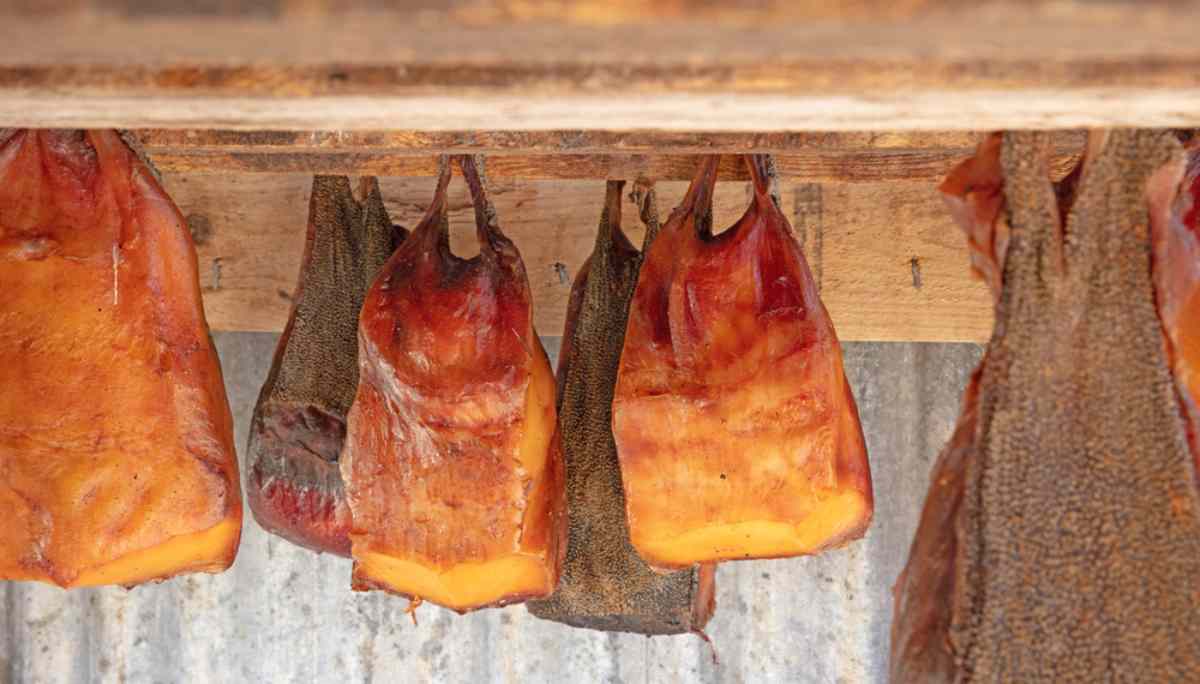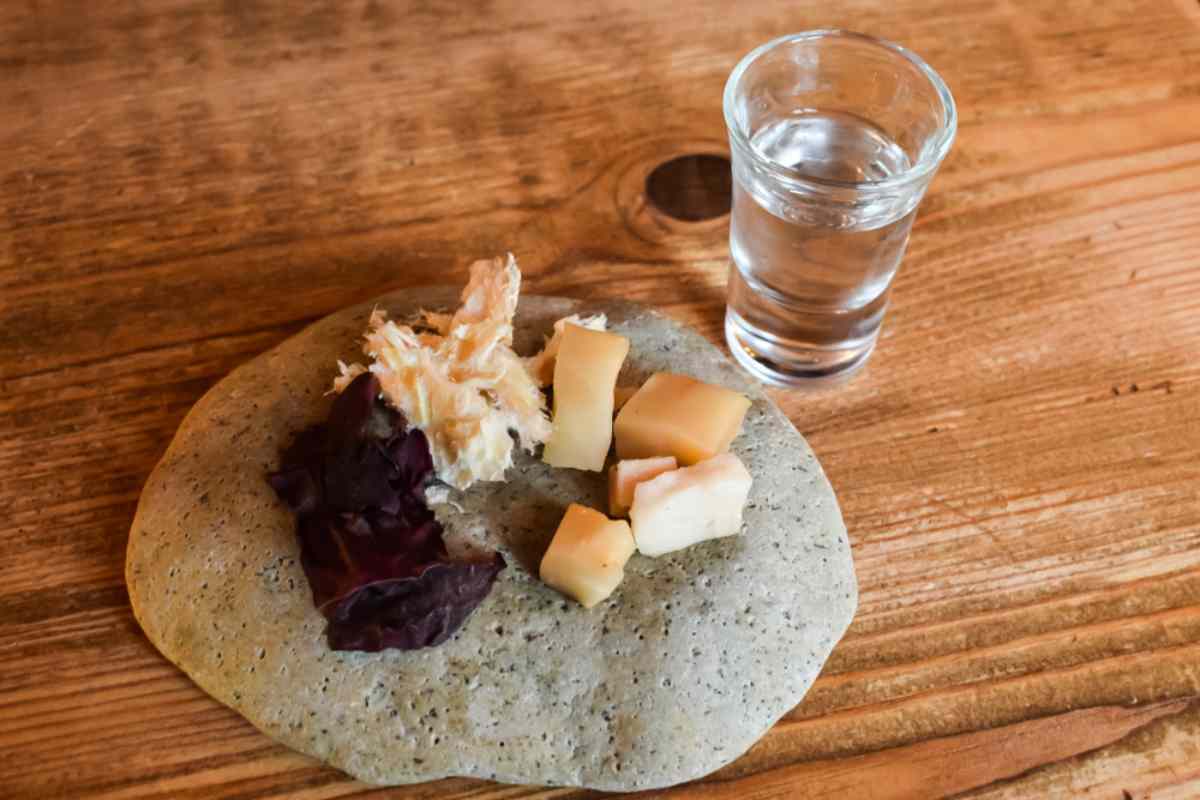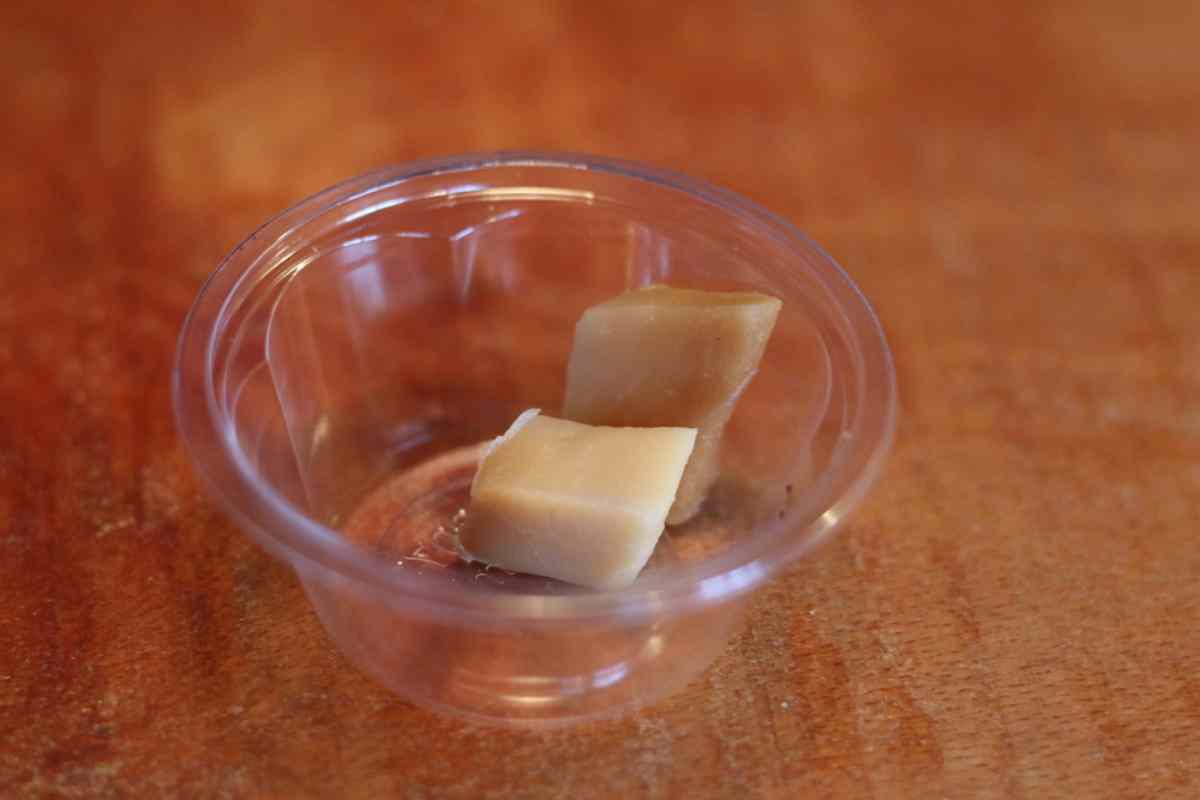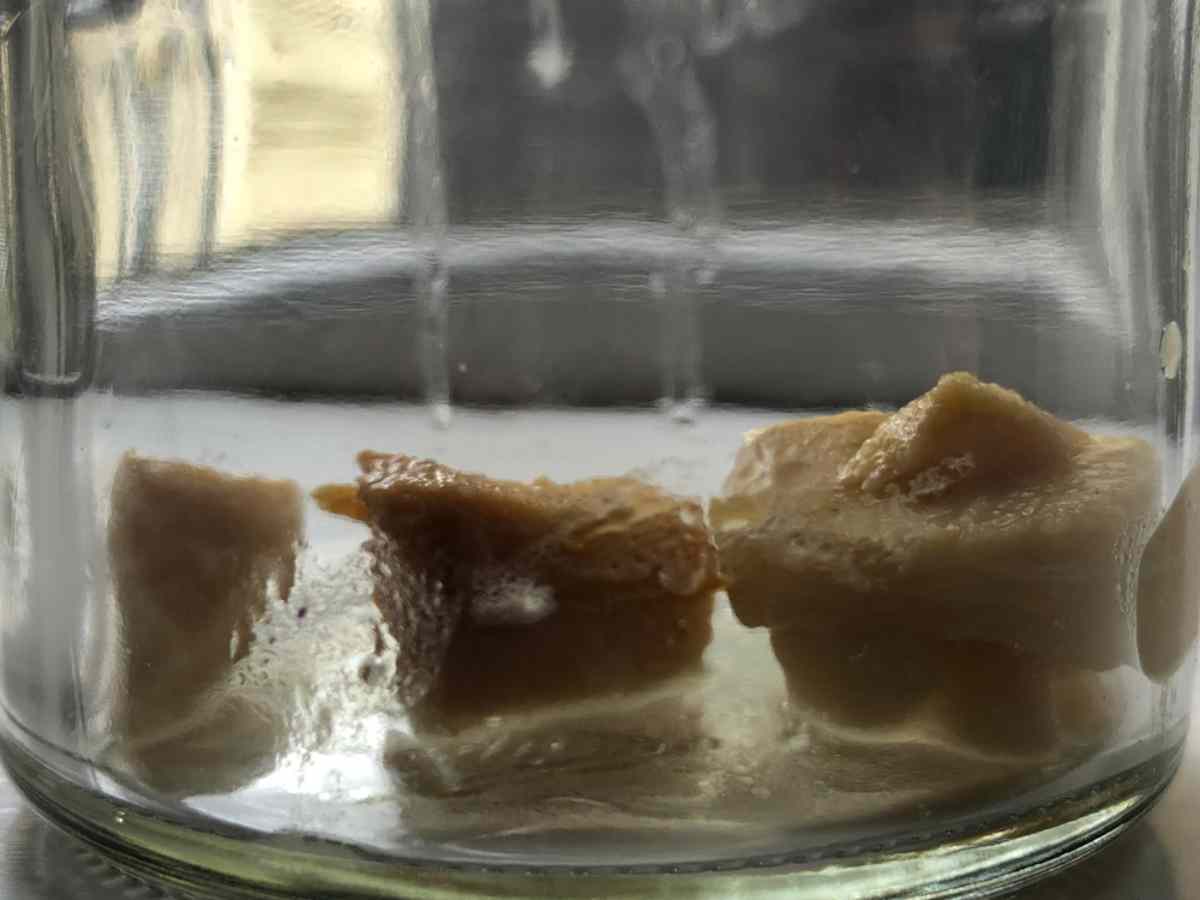Heads up, food lovers! Have you ever tried savoring a bite of fermented shark in Iceland? As savory as a pair of worn-out gym socks and as captivating as an unsolved mystery, hákarl is an Icelandic delicacy that's sure to tickle your adventurous spirit.
Imagine devouring a piece of history, dunked in tradition, and served on your plate. Here at Reykjavík Cars, your trusty guide to everything Iceland, we're no stranger to this unique cuisine. But let's dive deeper.
Is hákarl an acquired taste or a culinary dare? Buckle up because we're about to embark on a taste journey that's as wild as an Icelandic gale!
What is Fermented Shark?
Fermented shark in Iceland, locally known as hákarl, is a staple of traditional Icelandic cuisine. This national dish is typically made from a Greenland shark (or other sleeper shark species) preserved through a specific fermentation process and hung to dry for several months.
Suppose you're wondering why anyone would eat a fermented shark. In that case, the answer lies in Iceland's rich and tenacious history. This dish is a testament to the times when preserving food wasn't a choice but a critical means of survival during the harsh Icelandic winters.
History of Fermented Shark in Iceland
Diving into Iceland's history, one discovers that the tradition of consuming Iceland fermented shark, or hákarl, has deep roots. The origins of hákarl trace back to the Viking settlers who, out of necessity, developed methods to preserve their catch in the harsh Icelandic environment.
They found that by burying the shark underground and allowing it to ferment, they could neutralize the toxins present in the fresh meat. After fermentation, the shark was then hung to dry in open air.
This traditional method of preparing hákarl has been passed down through generations, becoming an integral part of Iceland's rich culinary heritage.
The Cultural Significance of Fermented Shark in Iceland
Iceland fermented shark is more than just a dish; it symbolizes Icelandic resilience and innovation. Rooted deep in the nation's history, hákarl has been a staple long before modern preservation methods existed.
The Vikings, Iceland's earliest settlers, turned to fermenting as a way to make the otherwise toxic Greenland shark edible, showcasing their adaptability to the harsh Icelandic environment. Hákarl plays a pivotal role in Icelandic traditions and celebrations, especially during the mid-winter festival of Þorrablót. During this festival, locals gather to celebrate their heritage, and hákarl is often the centerpiece, representing the strength and endurance of the Icelandic spirit.
Furthermore, hákarl is a testament to the nation's resourcefulness in the broader context of Icelandic cuisine. While modern Icelandic dishes have evolved, hákarl remains a cherished link to the past. For a deeper dive into Icelandic festivals and traditions, explore this comprehensive guide.

How Does Fermented Shark Taste?
When describing the taste and texture of Iceland's rotting shark, brace yourself for a sensory adventure. The initial bite is met with a chewy and slightly rubbery texture, somewhat similar to overcooked calamari.
However, the real kick lies in its taste – an overpowering rush of ammonia with a hint of fishiness that lingers. This potent flavor has been likened to a pungent cheese crossed with strong fish. For those who find the flavor too challenging, there are plenty of other culinary delights to explore, including a growing range of vegan and vegetarian food in Iceland. But for the adventurous, hákarl remains a must-try Icelandic delicacy.
How Fermented Shark in Iceland Made
The making of this Icelandic shark delicacy is a unique process that requires patience and precision. Here is a step-by-step overview of how fermented shark is prepared:
- Step 1: First, the shark is beheaded and gutted. The internal organs are removed to prevent the meat from spoiling.
- Step 2: The shark's meat is then cut into long, thick strips and placed in a shallow hole dug in gravelly sand, along with stones for weighted pressure. This allows the toxic fluids to seep out.
- Step 3: After this, the meat is left to ferment for 6-12 weeks, depending on the Icelandic weather.
- Step 4: Once fermentation is complete, the shark is removed from the pit and hung up to dry for several months.
- Step 5: The shark is then cut into smaller pieces and served as a traditional Icelandic dish, often accompanied by a shot of the country's famous Brennivín (a type of schnapps).
Nutritional Value of Fermented Shark
The Icelandic fermented fish holds a unique place on the nutrition scale. It is a rich source of protein and omega-3 fatty acids, which are essential for heart health and cognitive functioning. However, overconsumption may pose health risks due to its high sodium and cholesterol content.
When compared to other Icelandic foods, such as skyr (a yogurt-like dairy product) or rúgbrauð (Icelandic rye bread), fermented shark falls short in terms of balanced nutrition. Still, its cultural significance and unique flavor profile remain unrivaled.
Why Fermented Shark Has Such a Strong Flavor
The intense flavor of Iceland's fermented shark, or hákarl, is largely attributed to its unique fermentation process. When the Greenland shark is alive, its flesh contains harmful toxins.
To make it edible, the shark undergoes a fermentation process where it's buried in gravelly sand, allowing these toxins to seep out. This process also results in the formation of ammonia, which gives hákarl its characteristic pungent aroma and strong taste.
The drying phase that follows further concentrates these flavors. The combination of natural toxins, ammonia, and the drying process culminates in the robust flavor profile that makes hákarl a standout in Icelandic cuisine.

Is Fermented Shark Safe to Eat?
Have you ever wondered if that bite of fermented shark in Iceland is safe for your tummy? Fear not! While the initial idea of eating something fermented might raise eyebrows, the process actually makes the once-toxic Greenland shark safe to eat.
The fermentation neutralizes harmful toxins, and the subsequent drying solidifies its safety seal. However, like indulging in any exotic dish, moderation is key. Overindulgence might lead to a dance with the porcelain gods, but that's more due to its strong flavor than any health risks. So, go ahead, take a bite, and join the hákarl fan club!
Who Should Avoid Eating Fermented Shark?
While the Iceland shark delicacy, hákarl, is a rite of passage for many, it's not for everyone, and there are categories of people who should be cautious. Individuals with specific health conditions like high blood pressure or heart disease, due to the high sodium content, should refrain from consuming this dish.
Similarly, individuals with high cholesterol should also avoid it due to the dish's substantial cholesterol content. Furthermore, those following certain religious dietary restrictions should abstain, as this dish is made from shark meat. As always, when in doubt, it's best to consult with a healthcare professional.

Where To Find Fermented Shark in Iceland
Looking to savor fermented shark in Iceland? Here's where you can get a taste of this unique delicacy in Reykjavík:
- Restaurants: Several Icelandic eateries like Íslenski Barinn and Café Loki are well-known for serving fermented shark meat.
- Grocery Stores: For those who prefer to taste it in the comfort of their home, grocery stores such as Bónus often sell packaged hákarl.
- Bjarnarhöfn Shark Museum: For a truly immersive experience, visit the Bjarnarhöfn Shark Museum, where you can learn about the history process and even taste the shark. The museum even sells T-shirts to tell the world you've braved fermented shark in Iceland!
Tips for Eating Fermented Shark
Diving headfirst into the world of Icelandic fermented shark can be daunting. Here are some personal tips to make the experience a little more manageable:
- Try it with an open mind: The flavor and smell may be overwhelming initially, but approach it with an open mind and a sense of adventure.
- Take small bites: The strong taste can take some getting used to, so start with small bites.
- Chase it down with Brennivín: This Icelandic Schnapps, often dubbed 'Black Death,' is the traditional chaser. It helps in, well, 'neutralizing' the taste.
- Follow locals' tips: Many Icelanders recommend eating hákarl with a bit of rye bread. The bread's strong flavor helps balance out the taste of the fermented fish.
- Don't knock it until you've tried it: While hákarl may not be for everyone, it's worth giving this unique Icelandic delicacy a try before passing judgment. Who knows, you might just become a fan!

Alternative Icelandic Dishes for Those Not Ready to Try Fermented Shark in Iceland
If the thought of tasting rotting shark in Iceland sends shivers down your spine, fear not! Icelandic cuisine offers a wide array of dishes that are less intimidating than hákarl.
For starters, there's 'Skyr,' a creamy dairy product similar to yogurt but thicker and milder.
It's often enjoyed with berries or a sprinkle of sugar. 'Hangikjöt,' Icelandic lamb, is another must-try. Roasted, stewed, or grilled, the lamb here is renowned for its tender and flavorful meat, thanks to the free-roaming sheep grazing on Icelandic herbs.
Seafood lovers can rejoice with 'Plokkfiskur,' a comforting fish stew made with potatoes and white sauce. And let's not forget the unique ingredients that make Icelandic dishes stand out, like the Arctic thyme or crowberries. So, even if you sidestep the challenge of hákarl, rest assured Icelandic cuisine has a smorgasbord of flavors waiting for you!

How to Respectfully Decline Trying Fermented Shark in Iceland
Not everyone is ready to take the plunge and try Icelandic fermented fish or hákarl. And that's okay! The key is to politely refuse without offending your gracious Icelandic hosts. Start by expressing your appreciation for the offer, then gently let them know that you're still working up the courage for this unique culinary adventure.
You might say something like, 'I've heard that your Icelandic fermented fish is legendary, but my palate might need a bit more training first!' After all, who said that becoming an adventurous eater has to happen overnight?
How to Make Fermented Shark at Home
Are you thinking about bringing the taste of Iceland's fermented shark to your own kitchen? Here's your step-by-step guide to making this unique delicacy at home:
- Step 1: Start by sourcing a piece of Greenland shark meat. Be aware that due to its toxicity when fresh, it may be difficult to find.
- Step 2: Cut the shark into thick strips and bury the shark pieces in a shallow pit in gravelly sand. Place heavy stones on top to press out fluids.
- Step 3: Leave the meat to ferment at a cool temperature for 6-12 weeks.
- Step 4: After fermentation, hang the strips in a dry, well-ventilated area for 2-6 months, depending on the weather.
- Step 5: Once the meat has dried, cut it into bite-sized pieces and serve. Remember, the flavor is strong, so be prepared!
Note: This approximates the traditional process and may not fully replicate the authentic taste of Icelandic hákarl.

Tips for Making Fermented Shark Safely at Home
Safety should be your primary concern when attempting to make this Icelandic fermented fish delicacy at home. Here are a few helpful tips:
- Use Protective Gear: Always wear gloves and eye protection to avoid any irritation from the shark's naturally occurring toxins.
- Proper Ventilation: Ensure the shark is dried in a well-ventilated area to prevent ammonia build-up.
- Check Regularly: Monitor the fermentation process closely to avoid over-fermentation.
- Source Responsibly: Always source your Greenland shark from reputable suppliers to ensure its freshness and quality.
- Taste Test: Once dried, taste a small piece. If it smells off or has an unusual texture, it is better to play safe and discard it.
To Try or Not to Try Fermented Shark in Iceland?
Deciding on whether to plunge into a tasting adventure with the notorious fermented shark in Iceland is entirely up to one's palate and guts—quite literally! This iconic delicacy, steeped in historical significance, is certainly not for the faint-hearted.
If you're willing to take a culinary leap of faith, tasting hákarl could be the ultimate testament to your food explorations. Remember, being open-minded is the key when experiencing new foods and cultures. And now, the next step in your Icelandic adventure awaits! Don't just sit there googling, 'How strong is the smell of fermented shark?' - get out there and smell it yourself!
To truly experience Iceland, with all its unique foods and breathtaking landscapes, rent a car in Reykjavík. Remember, it's not just about the destination. It's about the journey... and the occasional whiff of shark!


 By
By


